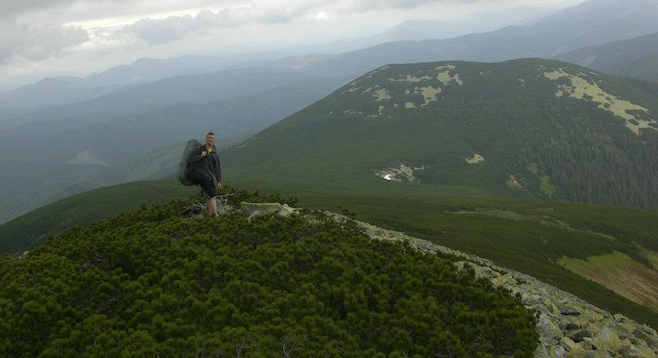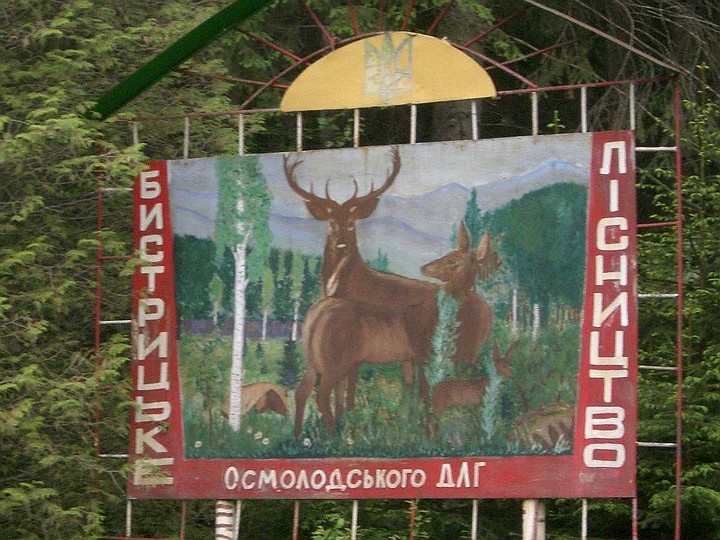 Facebook
Facebook
 X
X
 Instagram
Instagram
 TikTok
TikTok
 Youtube
Youtube

The Carpathian Mountains of Ukraine occupy the far western part of the country. They are considered moderate – nothing quite as massive or high as the Rockies, nor as rolling or subtle as the Appalachians. Yet they provide enough terrain for any adventure-savvy hiker to drool over.
You may be asking yourself, well, why should I visit the Carpathian Mountains? For starters, the Alps have turned into a Disneyland circus; though impressive, they aren’t quite the escape that they used to be. In a age when the internet has uncovered landscapes that were unknown to the traveler twenty years ago, who wouldn’t want a novel hiking experience?
A new country, Ukraine has only been open to Western capitalism a little over twenty years. Vast swaths of the Ukrainian Carpathians are untouched by hotels, vacation condos and ski resorts. If you’re searching for a true getaway, this is the place.
To hike the Carpathians, the ideal months are August and September. From October to late March, cold weather and impassable trails make it a bit rough. I’d done a previous trip in early June, but between April and the end of June the Carpathians receive significant (and often unpredictable) rainfall.
Our trip to the Carpathian Mountains was centered on the Ivano-Frankivsk oblast in August – the weather would be ideal and the days long. A 13-hour overnight train ride from Kiev took us to the western oblast (a large area of land much like a province. There are 24 oblasts in Ukraine).
From Ivano-Frankivsk, we took a 90-minute bus ride to Kalush. Once in Kalush we hitched another smaller bus and headed to the town of Osmoloda, our starting point. After riding a crammed bus for another 90 minutes and then navigating a rocky, crater-infested dirt road, we finally arrived.
As it turns out, Osmoloda isn’t really a town and isn’t really a village – more like a Wild West outpost. No visible humans were in sight along the one and only dirt street. Watermelon-sized horse droppings littered the street. A wolf-like dog trotted past, and a nearby wooden fence creaked eerily in the breeze. I expected John Wayne to come walking by any second and address me as “pilgrim.”
Behind Osmoloda, the Carpathians loomed in the distance, casting a massive shadow over the settlement and giving the place a cozy feel. Everything smelled of wood and pine. The whole place was dreamy and sublime.
Besides rudimentary logging equipment, there was only a group of splintered wooden houses along the main drag. After talking to a lone Ukrainian hiker, decked in military boots and a t-shirt that read “Space Man,” we learned that a small amount of logging takes place outside of town.
He continued to tell us that the scale of the logging is quite small when considering the large amount of unlogged mountain land that still existed. However, due to the slippery agreements between the logging companies and the local Ukrainian government, which turns a blind eye to this ruthless destruction, the escalation of logging was imminent.

There are four hiking routes heading out of Osmoloda, all marked by different colors: the red trail, blue trail, yellow trail and black trail. Each trail is an out-and-back loop and spans anywhere from 30 to about 60 kilometers. We took the red trail, a route which spans a little over 45 km (28 miles).
If you choose to hike into the Carpathians from Osmoloda, you’ll be rewarded with nightly accommodations along the trail. Small cabins are located along each trail for hikers who want to get out of the elements should the weather turn sour. Originally designed as rescue cabins, each is equipped with a wool sweater, matches, tea, and if you’re lucky, edible grains for the fatigued hiker.
Our plan was to spend each night in one of these aged cabins. Based on their rickety exterior, along with cobwebs and mustiness in the interior, these cabins creepily resembled haunted houses in the middle of the woods.

The first day we trotted a meager 15 km due to overgrown vegetation on the trail. The people who maintain the Carpathian trails in the Ivano-Frankovsk oblast are largely volunteers, so you must be persistent when encountering an untamed section. This process gives hiking a visceral, old-school approach compared to many of the well-maintained trails in the States.
We spent the first night in a wooden rescue cabin, meeting two Romanians who had come to the Ukrainian Carpathians to experience the wilderness. We traded Cliff Bars for smoked Polish sausage and talked of the grand adventures we were planning for the future. Things couldn’t have been much better.
The next day we climbed over sizeable ridgelines, above the tree line, and enjoyed spectacular views. Shrubs of fresh raspberries and blueberries lined the trails. We stained our hands, stuffed our faces, and buzzed like bees along the trail from all the natural sugar.
The next two days were spent following the red trail over six peaks, through meadows, across rivers, and through dark, eerie forests in which no sunlight penetrated.
At night, we “crashed” at other rescue cabins, and even though we slept on wooden boards, the aesthetic experience made it feel like we were sleeping on beds of feathers.
Towards evening, we trotted into Osmoloda smelling like dirtbag bums, having only seen six people in three and a half days. Opting for a swim in the icy river flowing on the outside of town, we bathed and nursed our inflamed muscles as a nearly full moon hung low between the crest of two peaks.


The Carpathian Mountains of Ukraine occupy the far western part of the country. They are considered moderate – nothing quite as massive or high as the Rockies, nor as rolling or subtle as the Appalachians. Yet they provide enough terrain for any adventure-savvy hiker to drool over.
You may be asking yourself, well, why should I visit the Carpathian Mountains? For starters, the Alps have turned into a Disneyland circus; though impressive, they aren’t quite the escape that they used to be. In a age when the internet has uncovered landscapes that were unknown to the traveler twenty years ago, who wouldn’t want a novel hiking experience?
A new country, Ukraine has only been open to Western capitalism a little over twenty years. Vast swaths of the Ukrainian Carpathians are untouched by hotels, vacation condos and ski resorts. If you’re searching for a true getaway, this is the place.
To hike the Carpathians, the ideal months are August and September. From October to late March, cold weather and impassable trails make it a bit rough. I’d done a previous trip in early June, but between April and the end of June the Carpathians receive significant (and often unpredictable) rainfall.
Our trip to the Carpathian Mountains was centered on the Ivano-Frankivsk oblast in August – the weather would be ideal and the days long. A 13-hour overnight train ride from Kiev took us to the western oblast (a large area of land much like a province. There are 24 oblasts in Ukraine).
From Ivano-Frankivsk, we took a 90-minute bus ride to Kalush. Once in Kalush we hitched another smaller bus and headed to the town of Osmoloda, our starting point. After riding a crammed bus for another 90 minutes and then navigating a rocky, crater-infested dirt road, we finally arrived.
As it turns out, Osmoloda isn’t really a town and isn’t really a village – more like a Wild West outpost. No visible humans were in sight along the one and only dirt street. Watermelon-sized horse droppings littered the street. A wolf-like dog trotted past, and a nearby wooden fence creaked eerily in the breeze. I expected John Wayne to come walking by any second and address me as “pilgrim.”
Behind Osmoloda, the Carpathians loomed in the distance, casting a massive shadow over the settlement and giving the place a cozy feel. Everything smelled of wood and pine. The whole place was dreamy and sublime.
Besides rudimentary logging equipment, there was only a group of splintered wooden houses along the main drag. After talking to a lone Ukrainian hiker, decked in military boots and a t-shirt that read “Space Man,” we learned that a small amount of logging takes place outside of town.
He continued to tell us that the scale of the logging is quite small when considering the large amount of unlogged mountain land that still existed. However, due to the slippery agreements between the logging companies and the local Ukrainian government, which turns a blind eye to this ruthless destruction, the escalation of logging was imminent.

There are four hiking routes heading out of Osmoloda, all marked by different colors: the red trail, blue trail, yellow trail and black trail. Each trail is an out-and-back loop and spans anywhere from 30 to about 60 kilometers. We took the red trail, a route which spans a little over 45 km (28 miles).
If you choose to hike into the Carpathians from Osmoloda, you’ll be rewarded with nightly accommodations along the trail. Small cabins are located along each trail for hikers who want to get out of the elements should the weather turn sour. Originally designed as rescue cabins, each is equipped with a wool sweater, matches, tea, and if you’re lucky, edible grains for the fatigued hiker.
Our plan was to spend each night in one of these aged cabins. Based on their rickety exterior, along with cobwebs and mustiness in the interior, these cabins creepily resembled haunted houses in the middle of the woods.

The first day we trotted a meager 15 km due to overgrown vegetation on the trail. The people who maintain the Carpathian trails in the Ivano-Frankovsk oblast are largely volunteers, so you must be persistent when encountering an untamed section. This process gives hiking a visceral, old-school approach compared to many of the well-maintained trails in the States.
We spent the first night in a wooden rescue cabin, meeting two Romanians who had come to the Ukrainian Carpathians to experience the wilderness. We traded Cliff Bars for smoked Polish sausage and talked of the grand adventures we were planning for the future. Things couldn’t have been much better.
The next day we climbed over sizeable ridgelines, above the tree line, and enjoyed spectacular views. Shrubs of fresh raspberries and blueberries lined the trails. We stained our hands, stuffed our faces, and buzzed like bees along the trail from all the natural sugar.
The next two days were spent following the red trail over six peaks, through meadows, across rivers, and through dark, eerie forests in which no sunlight penetrated.
At night, we “crashed” at other rescue cabins, and even though we slept on wooden boards, the aesthetic experience made it feel like we were sleeping on beds of feathers.
Towards evening, we trotted into Osmoloda smelling like dirtbag bums, having only seen six people in three and a half days. Opting for a swim in the icy river flowing on the outside of town, we bathed and nursed our inflamed muscles as a nearly full moon hung low between the crest of two peaks.
Comments